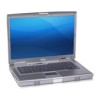Dell Precision M70 User's Guide - Page 34
Using the Drivers and Utilities CD, Manually Reinstalling Drivers for Windows XP - modem driver
 |
View all Dell Precision M70 manuals
Add to My Manuals
Save this manual to your list of manuals |
Page 34 highlights
2. Click Properties. 3. Click the Hardware tab and click Device Manager. 4. In the Device Manager window, right-click the device for which the new driver was installed and then click Properties. 5. Click the Drivers tab. 6. Click Roll Back Driver. Using the Drivers and Utilities CD If using Device Driver Rollback or System Restore does not resolve the problem, then reinstall the driver from the Drivers and Utilities CD (also known as the ResourceCD). NOTE: The Drivers and Utilities CD may contain drivers for operating systems that are not on your computer. Ensure that you are installing software appropriate for your operating system. NOTE: The Drivers and Utilities CD is optional and may not ship with all computers. 1. Save and close any open files, and exit any open programs. 2. Insert the Drivers and Utilities CD. In most cases, the CD starts running automatically. If it does not, start Windows Explorer, click your CD drive directory to display the CD contents, and then double-click the autorcd.exe file. The first time that you run the CD, it might prompt you to install setup files. Click OK, and follow the instructions on the screen to continue. 3. From the Language drop-down menu in the toolbar, select your preferred language for the driver or utility (if available). A welcome screen appears. 4. Click Next. The CD automatically scans your hardware to detect drivers and utilities used by your computer. 5. After the CD completes the hardware scan, you can also detect other drivers and utilities. Under Search Criteria, select the appropriate categories from the System Model, Operating System, and Topic drop-down menus. A link or links appear(s) for the specific drivers and utilities used by your computer. 6. Click the link of a specific driver or utility to display information about the driver or utility that you want to install. 7. Click the Install button (if present) to begin installing the driver or utility. At the welcome screen, follow the screen prompts to complete the installation. If no Install button is present, automatic installation is not an option. For installation instructions, either see the appropriate instructions in the following subsections, or click Extract, follow the extracting instructions, and then read the readme file. If instructed to navigate to the driver files, click the CD directory on the driver information window to display the files associated with that driver. Manually Reinstalling Drivers for Windows XP NOTE: If you are reinstalling an infrared sensor driver, you must first enable the infrared sensor in system setup before continuing with the driver installation. 1. After copying the driver files to your hard drive, click the Start button and right-click My Computer. 2. Click Properties. 3. Click the Hardware tab and click Device Manager. 4. Double-click the type of device for which you are installing the driver (for example, Modems or Infrared devices). 5. Double-click the name of the device for which you are installing the driver. 6. Click the Driver tab and click Update Driver. 7. Click Install from a list or specific location (Advanced) and click Next. 8. Click Browse and browse to the location to which you previously copied the driver files.















